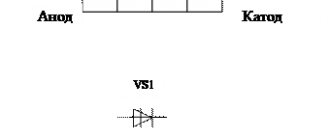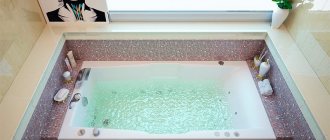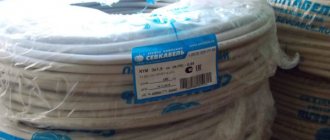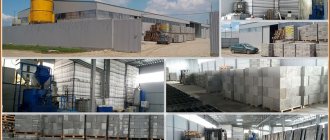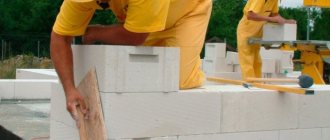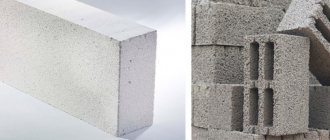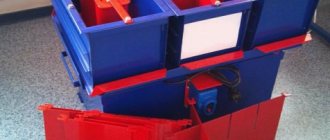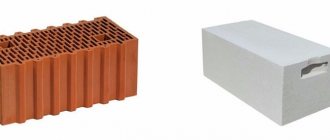Beton-House.com
Website about concrete: construction, characteristics, design. We combine the experience of professionals and private craftsmen in one place
Gas silicate and foam concrete
Comparing materials with each other is a hot topic for many developers. After all, each product has its own strengths and weaknesses, they differ to one degree or another in the features of use and operation. The question of the possibility of independently producing the material at home also remains important.
The use of the most modern materials is widespread among future owners. One of them is products made from cellular concrete. Therefore, in this article we will look for the answer to the question: gas silicate or foam concrete, which is better to choose for construction?
- Main quality indicators
- Necessary raw materials and equipment
Properties and qualities of gas silicate
Let's start with gas silicate. Let's figure out what kind of material it is, what properties it has and how practical a structure built using these products will be.
What is the material
Gas silicate has a special structure. It's all about the presence of a large number of cells that are formed as a result of the chemical reaction of the blowing agent and lime. This porosity gives the product a large number of advantages in the form of high quality indicators, which are most relevant in the construction of buildings. Let's use the table.
Table 1 Indicators of qualities and properties of gas silicate:
| Indicator name | Meaning |
| Thermal conductivity, W/mGrad | 0,1-0,3 |
| Frost resistance, cycles | 35-150 |
| Shrinkage, % | About 1.5 |
| Strength kg/cm2 | 5-20 |
| Density kg/m3 | 500-700 |
| Water absorption | Up to 20% |
| Single-layer wall thickness | From 0.4 m |
The numerical values of gas silicate are quite competitive. However, in order to compare gas silicate and foam concrete blocks, studying these characteristics is not enough.
Gas silicate blocks
Classification and scope of application
There are several types of classifications of gas silicate, one of the main ones is the division of products depending on their brand by density.
In this case, the following are distinguished:
- Thermal insulation, density up to 400;
- Structural and thermal insulation, density 500-900;
- Structural, with a grade of 1000-1200;
So:
- The first type is used as thermal insulation, since the thermal conductivity coefficient for low-density products is quite low.
- The second type is used in low-rise construction, as the main material in the construction of load-bearing walls and partitions.
- The third type, structural, is the most durable. It can withstand quite high loads, but its ability to maintain temperature is significantly reduced.
Thermal insulation and structural thermal insulation block
Depending on the purpose, the blocks are:
- Wall, used for the construction of walls;
- Partition walls, the thickness of which usually does not exceed 150 mm.
Products are also distinguished according to accuracy category:
- Blocks of category 1 have the best geometry; the maximum permissible size deviations should not exceed 1.5 mm. The laying is carried out using specialized glue with a minimum thickness of the seam.
- Blocks of category 2 are distinguished by more significant deviations, both in size - up to 2 mm, and in straightness, rectangularity of the ribs - up to 3 mm. Broken corners are also acceptable - up to 2 mm and ribs - up to 5 mm. Laying is carried out mainly using glue.
- Blocks of the third category are characterized by the following permissible values: deviations in size - up to 3 mm, in straightness and rectangularity - up to 4 mm, edges can be knocked off - up to 1 cm, and corners - up to 2 mm. Masonry work is carried out using mortar; the thickness of the seam increases significantly due to this.
All of the above block categories can be used in the construction of buildings. There are no distinctive characteristics other than deviations.
The price, of course, is different, but it can be more than compensated for by the additional costs of masonry mortar. A block of the third category is more often used in the construction of a garage, barn or other outbuildings. There are also other classifications, but the ones listed above are the most common and in demand.
Advantages and disadvantages of buildings
Gas silicate is a modern material; it is manufactured using new technologies and equipment. In this regard, manufacturers have long taken into account the shortcomings of old-time competitors, which directly helped make the material more advanced.
Let's look at the main advantages:
- The products are lightweight. This makes it possible to reduce the load on the foundation.
- The material is safe, it does not contain substances harmful to the environment
- Gas silicate is not flammable, which is undoubtedly a significant advantage. It can withstand high temperatures for several hours.
- Ease of processing. Building a house with your own hands is not difficult, and all you need is instructions. Products are easy to cut, saw, and polish.
- Large sizes. This requirement is dictated by technical documentation, since with such a density of the material, the use of smaller products is not possible. But at the same time, this is a plus: 1 block can replace the laying of up to 10-15 bricks! This fact will undoubtedly significantly speed up the construction process.
- Thermal conductivity index. Gas silicate has almost no competitors in this regard. It is capable of maintaining temperature better than many wall materials.
- Sufficient density for the construction of buildings up to 3 floors.
- The vapor permeability of the block will provide the most comfortable microclimate.
- High frost resistance, reaching 150 cycles, depending on the manufacturer. This means that the products can withstand alternating freezing and thawing processes up to 150 times.
These include:
- Water absorption of products. In this case, the porosity of the structure shows the other side of the coin. Moisture crystallized at subzero temperatures has a destructive effect on the structure of the block, significantly reducing its strength and performance characteristics.
With proper interior and exterior decoration, these consequences, of course, can be avoided, but this issue will have to be approached especially seriously.
- Fixation of fasteners should also be considered one of the weaknesses of gas silicate. When fastening, it is imperative to use special hardware for gas silicate (aerated concrete, cellular concrete). But if you want to fasten really heavy elements with a high level of tearing, the process will have to be thought out in advance. Fastening points must be reinforced, for example, with brick or metal.
- Products are fragile. They not only cut easily, but also break. Therefore, care should be taken during transportation and installation.
Specialized fasteners for gas silicate
Damage to gas silicate
This completes the list of negative aspects. As you can see, there are not many of them, but they are still significant.
Characteristics of foam concrete
Foam concrete is a slightly different material from gas silicate. Despite the fact that it is also a type of cellular concrete, its numerical characteristics are somewhat different. Let's analyze them.
Main quality indicators
Let's use the table.
Table 2. Characteristics of foam concrete:
| Indicator name | Meaning |
| Frost resistance, cycles | From 35 |
| Thermal conductivity W/m Deg | 0,14-0,22 |
| Shrinkage | 0.5-1 mm/m2 |
| Density kg/m3 | 600-1000 |
| Strength kg/cm2 | 15-25 |
| Water absorption | 10-16% by weight |
These characteristics, one might say, speak in favor of foam concrete. Except only for water absorption and shrinkage. However, if we take into account the fact that the perfect material for walls has not yet been created, foam concrete may well become attractive in the eyes of future building owners.
This especially concerns the cost of construction, but more on that later.
Types of foam concrete and their application
Depending on the brand, foam concrete is:
- Thermal insulation, with a grade of 150-400. Used as a material for thermal insulation. The load-bearing capacity of such products is minimal, but the ability to retain heat is quite high.
- Structural and thermal insulation. Characterized by density D500-D900. By analogy with gas silicate, it is used in the construction of walls and partitions.
- Structural, with a density of D1000-D1200, cannot boast of a low thermal conductivity coefficient, however, as you can see, the strength characteristics will allow the construction of a building up to 3-4 floors.
- Products with a density of D1300-D1600 are structurally porous. They have the highest density and thermal conductivity. GOST does not provide a standard for this material, so such batches are produced in small quantities and to order.
In accordance with their purpose, foam blocks are divided into:
- Products intended for the construction of load-bearing walls;
- For structures that will be subject to less load than load-bearing walls;
- Specialized building units in the form of: floor beams, Y-shaped blocks, and so on.
U-shaped foam concrete block
Like gas silicate blocks, foam concrete products are also classified depending on the accuracy category. Since all products made from lightweight cellular concrete are subject to the same GOST, it makes no sense to describe this classification; it is absolutely identical to the division of gas silicate.
Depending on the type of production and its nuances, there are also:
- Cut blocks, distinguished by the most distinct shapes;
- Molded. Such blocks are more typical for handicraft and home industries. Their geometry is not as good as the previous type;
- Reinforced with polymer fiber. These products are characterized by increased density, however, their price is much higher;
Fiber-reinforced foam concrete blocks, photo
There are also other classifications:
- Based on the content of the main binder component (cement blocks, gypsum, lime);
- In accordance with the type of silica component (sand, ash, other secondary industrial products);
- In accordance with the foam concrete curing method (autoclave and non-autoclave);
Strengths and weaknesses of products
The advantages of foam concrete include:
- Low specific gravity, from 0.4 to 0.8 tons/m3;
- Low thermal conductivity coefficient. In this, the block is significantly superior to brick and some other types of wall materials;
- Attractive price. To build walls from foam block is approximately 20-25% cheaper than from brick and, for example, 15% cheaper than from wood concrete;
- The material is environmentally friendly. In this regard, foam concrete is superior only to wood. For him this indicator is 1, and for the block it is 2.
- Not susceptible to biological effects and, as a result, not prone to the appearance of fungus and mold;
- The fire resistance of the products is also excellent;
- Strength indicators, taking into account thermal conductivity, are very enviable. Using foam blocks, it is quite possible to build a house several floors high;
- Ease of handling will significantly increase the speed of construction;
- Possibility of fiber reinforcement to increase the strength of structures.
Gas silicate blocks or foam concrete blocks
The main disadvantages are as follows:
- The material is hygroscopic. The ability to absorb water is quite high, but since foam concrete has closed pores, it is still less saturated with moisture than gas silicate.
- The products are fragile, any mechanical stress can lead to destruction of the block.
- Shrinkage. Although this indicator for foam concrete is not the highest among wall materials, it is not the smallest. There is a possibility of cracks appearing.
- As in the case of gas silicate, the fasteners are poorly fixed. Requires the use of specialized hardware.
If you carefully consider all of the above disadvantages of both materials, it is not difficult to notice that they are almost identical. So what to choose: gas silicate blocks or foam concrete?
Pros and cons of materials
Gas silicate: strengths and weaknesses
When performing construction work, the consumption of mortar for joints is reduced.
The following qualities are considered positive:
- good strength;
- thermal conductivity is high;
- homogeneity of structure;
- frost resistance;
- good adhesion, which requires a thin masonry seam;
- vapor permeability, due to which the walls breathe.
But there are also disadvantages:
- Only adhesive compositions are suitable for products.
- High cost of production: high cost of the process itself and equipment.
Foam concrete: what attracts you?
- Low cost.
- Good bending strength, no shrinkage.
- For masonry, you can use cement-sand mortar and adhesives.
- Moisture resistance.
- It is possible to produce blocks with your own hands, but the quality will be lower.
Foam concrete will retain less heat in the room than its opponents.
Weak sides:
- insufficient strength and frost resistance;
- less energy saving properties.
Aerated concrete and its features
The advantages of working with the material include:
- low cost;
- safety, environmental friendliness;
- no need to insulate the house;
- ease of operation and construction of structures of any complexity;
- non-flammability.
Negative sides:
- the need to plaster the wall;
- appearance of cracks after shrinkage.
Comparison of materials
Let's start with a direct comparison of materials. The main difference, of course, is the process of pore formation. When producing foam concrete, this is facilitated by the addition of a specialized foaming agent, which gives the material a similar structure.
In the case of aerated concrete, everything is somewhat different. The process of gas formation occurs, as mentioned above, as a result of a chemical reaction that occurs during the interaction of lime and aluminum powder.
The pore structure of these materials is also different. For aerated concrete it is open, and for foam concrete it is closed. These and some other factors cause fundamental differences between products.
Let's get acquainted with the differences in physical, mechanical and technical properties, and also compare the practical and performance qualities of the materials.
Table 3. Comparison of foam concrete and gas silicate:
| Property, quality | Gas silicate blocks and foam concrete blocks |
| Thermal conductivity | The heat retention ability of both materials is approximately equally good. Both foam concrete and gas silicate heat up slowly and cool down just as slowly. This fact can significantly reduce the cost of heating the premises in the future and reduce the costs of insulating the building. |
| Frost resistance | In this indicator, gas silicate is clearly superior. Manufacturers promise up to 150 possible freezing and thawing cycles, while foam concrete is characterized by 35-70 cycles. |
| Installation speed | Absolutely the same. Both materials are easy to process and can, under mechanical influence, take any shape. In addition, the construction process is directly influenced by the dimensions of the products. For comparison, 1 block replaces a masonry of up to 15 bricks. |
| Construction cost | Foam concrete is about 10-15% cheaper. |
| Additional expenses | The use of any of the products during construction will incur additional costs. This applies to both exterior and interior decoration. For example, both foam concrete and gas silicate have poor adhesion to finishing materials. In this regard, it will be necessary to purchase primers, reinforcing mesh and expensive specialized compounds. |
| Environmental friendliness | The composition of the materials is characterized by the presence of mineral components that are not toxic. Products do not harm the environment or humans |
| Fire resistance | Both foam concrete and gas silicate are fire resistant. |
| Appearance and geometry of the block | These indicators speak in favor of gas silicate, especially in comparison with non-autoclaved foam concrete. The production technique of the first allows us to produce blocks that are almost ideal in their geometry. |
| Variety of manufacturers and sizes to choose from | Gas silicate is again partially ahead, but only in terms of the choice of manufacturer. This is due to the greater prevalence of this material. As for the variability of sizes, there is no winner in this aspect. And among foam concrete and gas silicate, any developer will be able to choose a suitable block. |
| Soundproofing | Foam concrete has good sound insulation, but gas silicate has a higher level of sound insulation. |
| Vapor permeability | Both materials have the ability to exchange vapor: with high air humidity, it is partially absorbed, and with a predominance of dry air, it is released. Thanks to this, the most favorable microclimate is established in the building. |
| Variability of external and internal decoration, possible difficulties | Both foam concrete and gas silicate can be finished with almost any materials, the main thing is to follow several important rules:
|
If you do not take into account the cost, then the leader among materials is obvious.
Foam concrete or gas silicate? The choice is yours. And for complete conviction and for connoisseurs of self-production, we will consider the production technology of each material and find out which of them, in this case, will be ahead.
Gas silicate foam concrete blocks, expanded clay concrete: external difference
Block comparison
To find out how a foam block differs from a gas silicate block, it is necessary to analyze their main characteristics:
- Strength;
- Thermal conductivity;
- Frost resistance;
- Moisture resistance;
- Environmental friendliness;
- Fire resistance;
- Weight and size;
- Soundproofing;
- Easy to use;
- Price.
The strength of both materials is almost equal; they are divided into three types:
- Thermal insulation;
- Structural and thermal insulation;
- Structural.
Therefore, they are used for the same types of work. The only thing is that gas silicate has a higher density due to the production technology, so it is used for the construction of multi-story buildings. You choose what is best for building a house. Foam blocks are used only in the construction of buildings no higher than three floors.
Their thermal conductivity parameters are the same, the blocks perfectly retain heat in the room and also maintain the microclimate. For additional insulation of houses, blocks of a grade no higher than D 500 are used.
The frost resistance of cellular concrete is quite high; due to the porous structure of the material, water has room to expand (when freezing), as a result of which the integrity of the building is maintained. Foam blocks are noticeably inferior to gas silicate in this indicator; for the latter, manufacturers claim up to 150 cycles, while for foam blocks the figure stopped at 75.
Moisture resistance - this parameter is low for both types of block. The material absorbs moisture and gradually deteriorates.
Gas silicate and foam block are environmentally friendly materials; only safe elements are used in their production. The blocks are not susceptible to rotting, mold, or fungus.
Fire resistance - both can withstand the temperature of an open fire for 8 hours.
The dimensions and weight of gas silicate blocks and foam concrete blocks are almost the same. They are quite light, come in various shapes and sizes, there is not much difference here.
The sound insulation of a foam block is higher than that of gas silicate, but not by much. In addition, the foam block is easier to process, easier to drill and saw into pieces.
The cost of materials is not much different, but the foam block is clearly lower. But gas silicate compensates for this with its appearance; the blocks are perfectly smooth, unlike foam concrete.
To summarize, I would like to note that gas silicate and foam block are very similar to each other, the technical properties and characteristics are almost identical. The main difference is the increased strength of gas silicate blocks, which allows the material to be used in the construction of tall buildings.
Features of the production of foam concrete and gas silicate
The production process of both materials is somewhat similar to each other, but it is the presence of differences that determines the final result that is different from each other. The technology itself fundamentally influences future performance indicators. Let's study them, and start with the necessary set of machines and raw materials.
Necessary raw materials and equipment
To produce gas silicate, you will need the following materials:
- Water;
- Quartz sand;
- Cement grade not lower than M400;
- Quicklime;
- Aluminum powder that serves as a gas-forming agent.
Composition of gas silicate
There may be several options for a set of equipment. The most common among large enterprises is the use of an automated conveyor line.
Its use almost completely eliminates human participation, thereby reducing labor costs and significantly speeding up the production process. The disadvantage of this line is the high price.
Gas silicate production line
The second option could be a landline. In this case, the autoclave must be purchased separately. You can choose the package yourself and, of course, both productivity and labor costs will depend on this.
Fixed line
Standard landline includes:
- Dispenser for both liquid and bulk components;
- Gas concrete mixer;
- Forms;
- Autoclave;
- Transportation equipment;
- Cutting apparatus.
- Cement;
- Fine sand;
- Water;
- Foaming agent.
To produce non-autoclaved foam concrete in a factory, you will also need machines and machines:
- Bunkers for storing bulk materials;
- Foam concrete mixer;
- Forms;
- Cutting complex
- Foam generator.
If you plan to process the material in an autoclave, of course, it should be purchased additionally.
Note! It is also worth considering that in addition to the above equipment, the company also needs additional equipment. This could be, for example, a forklift, various containers.
If you want to produce it yourself, you can limit yourself to the availability of a foam concrete mixer and molds.
Description of technological processes
Let's start with the production of non-autoclaved foam concrete in a factory using classical technology.
The process includes a number of steps:
- Cement and sand are moved into the foam concrete mixer;
- Water and foaming agent, passing through the foam generator, also enter the mixer;
- The components are thoroughly mixed;
- Next, the prepared solution is poured into the mold;
- Semi-finished products are cut using a special complex;
- Next, the blocks must reach technical maturity by hardening. At the same time, they can be heated to speed up the process.
Scheme of foam concrete production in a factory
If we talk about monolithic foam concrete, its production can be done using several technologies:
- Pressure technology, in which a foam generator is not used. Foamed concrete is produced in a pressure mixer under excess pressure. The mixture is usually used to construct monolithic structures.
- Dry mineralization technology. This method is most relevant for continuous pouring of the composition at a facility under construction. It consists of introducing the components in a dry state into a foamy mixture.
Scheme for the production of monolithic concrete
The gas silicate manufacturing technology also contains the following steps:
- The necessary components are dosed and supplied to the aerated concrete mixer, where they are thoroughly mixed;
- The finished solution is poured into a mold, where the process of gas formation occurs;
- Next, the array passes through a hot tunnel;
- Next comes turning and cutting of the product to the required dimensions;
- The blocks enter the autoclave, where they are finally hardened.
Gas silicate production diagram
Note! As for the independent production of blocks, this is only possible if non-autoclaved foam concrete is produced, because it is unlikely that anyone will decide to purchase and place an autoclave at home. The principle remains the same: the components are mixed, poured into molds and hardened naturally.
When choosing gas silicate or foam concrete blocks, those wishing to carry out the process themselves, of course, should pay attention to the above type of cellular concrete. And the video in this article will tell you more about the technology for making the material at home.
Profitability of production
As for the profitability of the production of foam blocks and gas silicate, this is a fairly profitable business. Let's look at the example of gas silicate. A stationary production line for these economy class products will cost approximately 500,000 rubles. At the same time, it will include all the necessary equipment, including an autoclave.
If you purchase used machines or arrange delivery from China, you can save a lot.
The final cost will depend, of course, on the set of machines, their manufacturer and, first of all, on the desired power. If we talk about profitability, it is not possible to give exact figures.
The fact is that possible profit depends on many factors, the main ones of which are:
- Purchasing power in the region;
- The number of products produced per day and the period for its sale;
- Cost of capital investments, business expenses of the organization;
- Labor costs and various deductions, including taxes.
If we assume that the market value of 1 m3 of a block is 3200, and its cost is about 1800-2000, then the business cannot be called unprofitable. The average payback is 8-12 months.
Production costs
Main results
Foam concrete and gas silicate are types of cellular concrete. Both materials have a number of positive characteristics, but there are also weaknesses.
Some of their indicators are extremely similar, but their different characteristics make you think about the practicality of using one of the materials. Water absorption is the main disadvantage of products made from these types of concrete, but with technically correct finishing, negative consequences can be avoided.
The production process, with automated equipment, is quite simple. However, if you want to make blocks with your own hands, then you should prepare for a serious investment of time and effort.
If you are faced with a question: which is better, foam concrete or gas silicate blocks? First of all, you should decide which indicators are most important for you when building a house. In this case, the answer will be much easier to find.
Similarities and differences in manufacturing
Foam concrete and gas silicate have almost the same composition. The components that are present in both materials are water, cement, sand. Since these cellular compositions are identical, they have the following advantages:
- resistance to fire;
- resistance against mold, mildew, rot;
- resistance against damage to walls by various rodents;
- ease of installation.
The production of foam concrete is much simpler than gas silicate.
If you know the nuances of brickwork, then you can handle masonry with gas silicate or foam concrete on your own. It is for these reasons that most people face a choice - brick, gas silicate or foam concrete?
It is worth considering the nuances of manufacturing foam blocks, as well as gas silicate:
- The foam block is produced thanks to a production technology in which a foaming agent is added to the concrete solution. Only after this the resulting mass is poured into special molds, where it gains strength and strength.
- During the chemical reaction of unslaked lime with aluminum, gas silicate is made. The mass of this substance includes small parts of aluminum powder. As this reaction progresses, hydrogen rises to the top in the form of a gas, which forms a cellular structure. This material is produced in the form of large blocks. Gas silicate can be used only after the mass has hardened and been cut into the necessary blocks.
It is these differences in production that influence the characteristics of the resulting building materials.
Return to contents

